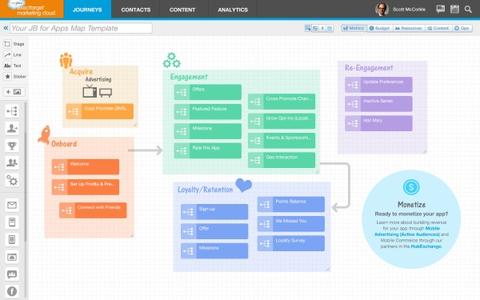Add new comment
Implications for Nonprofits from the Salesforce Marketing Cloud Keynote
This morning I watched the marketing keynote from Salesforce’s Dreamforce conference. What follows is a grab bag of implications for nonprofits, activists and the social impact field in general. Let me know what you think in the comments or @fitz350.
- The corporate world is moving to quickly integrate all marketing channels. While the “customer” experience has been cross-channel for years (think of using your phone to price-check something in a store, or to look up the yelp review of a restaurant you’re standing outside of), marketing data has mostly been siloed. Websites, and now apps, will increasingly deliver content that changes based on your behavior on other channels (email, web, social, even internet-of-things).
- While individualized content has the potential deliver more of what we want, and less of what we don’t, there’s a real benefit to anonymity and the serendipity that results from unplanned interactions with the world.
- We (still, and now more than ever) need strong protections for individual data. Complex algorithms could easily become black boxes of automated discrimination. You should have the right to see (and contest, and remove) the information being stored about you.
- Salesforce is betting heavily on the idea of putting the customer at the center of the experience, of building (or shifting toward) companies that are customer-centric. If you haven’t mapped out the various “journeys” (to use Salesforce speak) that your clients, supporters, donors or constituents go through when they interact with your organization, you’re definitely going to miss opportunities to improve their experience, let alone enhance that experience through individualized support or engagement.

A screenshot of the Journey Builder dashboard in the Salesforce Marketing Cloud.
Each series of events can be triggered by a particular customer or constituent's actions (or lack thereof).
- These “journeys” are the building blocks for customizing campaigns within Salesforce’s marketing platform. Think of the ubiquitous nonprofit donor welcome cycle. For example, you make a donation, you get a thank you email in which you’re asked to signal your interests and then you get a piece of direct mail tailored to your response. Each step of that process can be customized, optimized and analyzed. Did you just hit 10,000 steps for the first time, or recruit your first volunteer? There’s a “journey” designed to take you from that point to converting some business or organizational goal. Smart organizations will remember that your personal goals are the driving force behind your engagement.
- Digital geo-fences are increasingly being deployed to trigger individualized content. In the corporate world this means sending you a coupon on your phone when you walk in the mall, but imagine signing up for a demonstration and having a push notification show up when you get a block away that reminds you to tag your social posts with a particular hashtag, or advises you to take a different route to navigate road blockages. This same function could, of course, be used by a malicious government to identify people who attended or were just in the area of the protest.
- Networked content syndication is upon us. McDonald’s just announced they’ll have all 14,500 stores with their own Facebook page by the end of the year. A video case study explained how the company will use Salesforce’s Marketing Cloud to offer pre-made social content to local stores through a shared archive of posts, made by corporate HQ, that local page managers can choose to edit and publish. The applications for a large NGO with local chapters or affiliates - such as United Way, Y-USA or Sierra Club - are obvious. Potential benefits include freeing up local staff time, pooling resources to create higher quality content, and increased coordination. Potential challenges include over-scheduling of posts (where many campaigns, plus fundraising, are competing for publishing time and audience interaction), a loss of local voice as content gets mass-produced and homogenized, and the risk of increasing the perception that communications are something done by some people or other people in an organization, rather than by everyone (with direction and support from specialized staff).
- Bubbling up the best content from a formal or informal network is still a place where there’s a need for improved tools. CrowdTangle, NewsWhip and (our very own, far more ocean-y and quite different) Tide Report are all examples of how to approach this network or movement-level information flow issue.